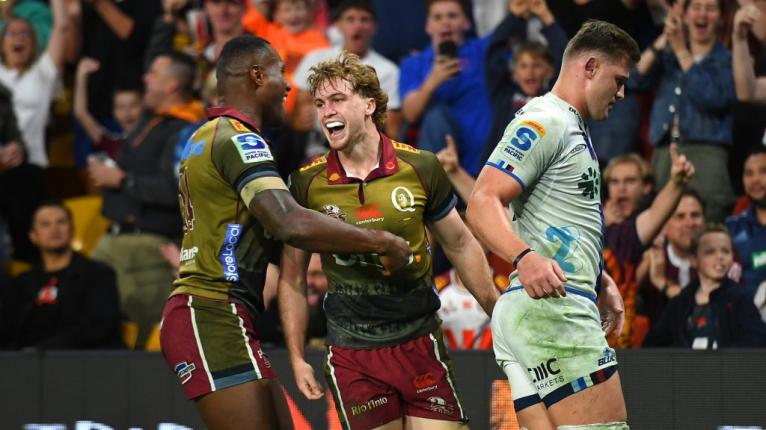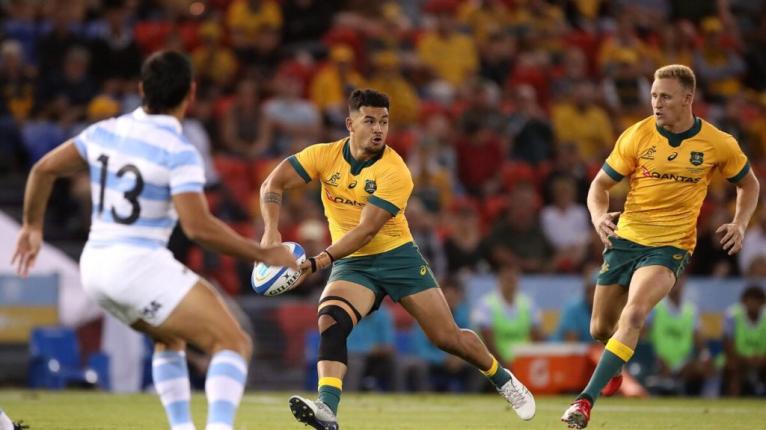Make no mistake, Australian rugby is under siege as never before, and it is fighting a battle on two fronts. Insidious forces, internal and external, are threatening to tear union apart. From within, an NRL pricked into action by the baiting of previous chairman Hamish McLennan is looking to poach the very best players the rival code has to offer; from without, Japanese and European clubs are intent on carrying Australia’s most prized assets to far-flung fields in the prime of their careers.
It makes life very tough indeed for newly-arrived Wallaby head honcho Joe Schmidt. Like any top international coach, Schmidt wants to build strength in depth in every position on the field, knowing that strength-in-depth builds consistency. Injury or unavailability? No problem. One player drops out, and another with the same quality and a similar skill-set slots in seamlessly to take his place. The machine keeps purring without missing any gears.
That process cannot happen so smoothly in Australian rugby – and the latest signs suggest it cannot happen at all. Take the case of inside centre and right wing, which should by rights be two of the strongest spots in the national side. At number 14, by the end of last year’s World Cup there was a depth chart composed of upwardly mobile Mark Nawaqanitawase, supported by Jordie Petaia, Suliasi Vunivalu and the likes of Izaia Perese and Andrew Kellaway.

Nawaqanitawase promptly signed for the NRL’s Roosters in December, after providing one of the few bright spots of the campaign in France. Only six weeks ago, the jungle drums hinted Petaia might be following the youthful Waratah to the St George Illawarra Dragons. Both share the same agent, so a coincidence it is not. Perese has already confirmed his departure to Leicester Tigers in the English Premiership for the 2024-2025 season.
Naturally Queensland head coach Les Kiss wants to hang on to Petaia, even if his impassioned plea to Rugby Australia could just as easily have spilled from the lips of Schmidt himself.
“I think [the issue] is front and centre. When I talk about succession, I always put retention first, and recruitment second. Someone like Jordie is important [in relation to] who you want to retain. Keeping good rugby players is important in the game.
“There’s massive upside in Jordie. I know he can play [number] 15, [number] 13, [and] wing. Increasing other skill-sets are the things that excite him.
“Everything should be done in a sustainable way, but someone like Jordie is important to keep here. He is the type of player fans can connect with. He’s got something special. He’s super competitive, strong, big, powerful.”
The most intriguing option of all is Vunivalu, who was selected for the World Cup squad well before he was thoroughly ‘cooked’ by experience in Super Rugby. With Petaia out injured for the season, Kiss has been fast-tracking the Fiji-born Queenslander through a crash course of dos and don’ts for a modern wing.
Coach and player share a sizeable, sympathetic overlap with their rugby experiences in the sister code. The ex-leaguer has begun to move if not shake, with improved work rate and an evident desire to get stuck in and do the basics well. He has found the right coach to improve him at provincial level and he may yet discover the right man to polish an international diamond later in 2024.
Just like right wing, inside centre should read like a star column, but instead Australian rugby finds the print disintegrating in its hands like wet newspaper. World-class midfielder Samu Kerevi, who will turn 31 in September, has chosen to stay in Japan with the Urayasu D-Rocks, on a $1.5m AUD two-year deal. Rugby Australia was unable to match either the length of contract or remuneration needed to bring him home.
The next cab off the rank is Hunter Paisami, and he is being courted by that long-time centre of excellence for Australians playing abroad, Exeter Chiefs. With RA only offering a limited one-year top-up deal, the odds are stacked in favour of a move to southwest England.
Under Kiss’ tutelage, Paisami has finally developed into the kick-pass-run ‘triple threat’ first envisaged by previous Wallaby head coach Dave Rennie at the start of the last World Cup cycle back in 2020. Kiss again:
“[Hunter] tells me he can goal-kick, drop-kick as well. He tells me he can do everything. But he just hasn’t stopped surprising me. He’s a professional. He is a joy to have around the place.

“He still does that first job as a 12 by creating quick ball on the gain-line. He can be that target player, or a genuine second five-eighth.
“His kicking game has been exceptional. I don’t think it’s a revelation. It’s always been there. It is just the style of rugby you play [that] can open it up.”
If Paisami does leave for pastures new, it will leave only Lalakai Foketi among the top three 12s in Australia, and he is currently playing a losing hand in New South Wales. Both Kiss and Schmidt will be closing their eyes, and hoping against hope Paisami stays, and Vunivalu keeps making strides forward.
Vunivalu’s extraordinary, Folau-like leaping ability and body control in the air has always been a huge point-of-difference in his favour. Remember this try against France in the 2023 warm-up Test?
It is a straightforward one-on-one with a bona fide international full-back [Melvyn Jaminet] but Vunivalu makes it all look as easy as child’s play to catch the ball and walk across the goal-line.
He pulled much the same rabbit out of the hat against Blues in round 10 of Super Rugby.
It’s a set play designed to give Vunivalu the opportunity to beat one man in the air, and another on the ground, and he manages both tasks with sumptuous ease – the only problem was he forgot to apply pressure while dotting the ball down, knocking it on instead!
The biggest single difference with the 2023 and 2024 versions of the 6ft 4ins back lies in his attention to detail at the attacking breakdown. Earlier in the season, he saved a succession of potential turnovers after a Reds break had been made, a situation primed for defensive steals. The same was true of his contact work against the Blues.
In both instances it is that ‘big-wing’ ability to stem the Aucklanders’ counter-ruck at source on a second-man arrival which firstly, opens up a short-side for Harry Wilson to exploit; and secondly, creates quick ball for a Paisami cross-kick to the far side after a long break by Josh Flook down the right.
If Vunivalu’s accuracy at attacking breakdowns and his work rate on the opposite side of the field [he scored a try in the left corner in the 47th minute] should keep him in the frame for Schmidt’s July squad announcement, Paisami’s improved short kicking game will undoubtedly achieve the same aim.
The weighting of the chip over the front line of defence, and the instant all-in-one transfer after the regather is just too exquisitely-timed for newbie Tim Ryan to turn down the chance on the left wing. Kick and pass are two prongs of the triple threat, but it is Paisami’s dynamic power on the carry which remains the basis of his game.

Size is irrelevant. It just doesn’t matter it is the two Blues second rows – 6ft 6ins and 120KG of Patrick Tuipulotu and 6ft 8ins and 110KG of Sam Darry – opposing Paisami in the first clip, or 6ft 4ins and 105KG of centre Bryce Heem trying to drag him down in the second. Paisami’s dynamic power in contact counts for more. The screenshot shows the typical Kiss base-shape on attack, which will also be a Schmidt foundation stone. Paisami is at first receiver, his partner Flook hits on a short line outside and 10 Tom Lynagh is drifting around the back of the two centres to link the attack out wide.
The power threat has made Paisami the Reds’ most reliable ball-carrying back in 2024 with 74 carries and 23 tackle busts, and transformed him into a demon on defence, with 12 dominant hits and three breakdown pilfers when ball goes to deck.
Three good actions in the space of ten seconds: a well-timed rush on to the Blues 11 to force the initial error, then a follow-up strip on Mark Telea, with an instant pilfer to complete the sequence.
Kiss has already discovered Australian professional rugby is in a race against time. As quickly as he develops a good new one, that player is likely to disappear into the European or Japanese game, or even the NRL. What looks like excellent depth for both Kiss and Schmidt turns to dust too quickly for the liking of either.
The stocks on the right wing have been devoured. Suddenly, the continued progress of Vunivalu is a need not a luxury. Likewise, the extension of Kerevi’s Japanese sojourn and Paisami’s possible migration to Exeter has left the store at inside centre bare. It will test the well-seasoned mettle of even Kiss or Schmidt to find the silver thread in that labyrinth of uncertainty.



Comments
Join free and tell us what you really think!
Sign up for free